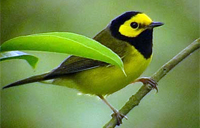Purple Martin songbirds fly from the northern United States to the Yucatan in one week, where they suddenly stop for a two to three week “vacation,” York biology Professor Bridget Stutchbury told the capacity crowd at the inaugural James (Jim) B. Love Lecture in Avian Conservation.
A former Canada Research Chair in Ecology and Conservation Biology, Stutchbury specializes in songbird conservation and has been researching the migratory routes of the declining population of songbirds migrating between Canada and the tropics.

Recently it has become possible to track the entire 10,000-kilometre migration route of individual songbirds, allowing researchers to map out critical habitats used during migration and for surviving until they return in spring.
At the March 25 James Love Lecture, named after Love in recognition of his tremendous support for Faculty of Environmental Studies (FES) and the University, Stutchbury fascinated audiences with her breakthrough migration tracking results for Purple Martins, Red-eyed Vireos and Wood Thrushes.

Stutchbury of the Faculty of Science explained how tiny geo-locators are placed on the back of the birds like backpacks and how they fly to their wintering grounds in Central and South America carrying this “luggage.” These locators are not live-feed or GPS, rather they use sunlight exposure to estimate the birds’ location via sunrise and sunset times. The devices must be retrieved from the bird after it returns the next year.
Stutchbury’s research on songbird migration has brought many surprises. Like the Purple Martins, the Red-eye Vireos also stop in the fall for nearly a month, but in Cuba. In the spring, a remarkable 70 per cent of Wood Thrushes stop in coastal Louisiana during spring migration. These data help conservationists decipher which locations should be conserved to help stop the strong population declines in these songbirds.
Dean Noël Sturgeon of FES welcomed the guests, and spoke on behalf of Jeff O’Hagan, vice-president of advancement, who brought words of thanks and recognition from President & Vice-Chancellor Mamdouh Shoukri.
“Jim Love’s support has contributed towards the vibrancy and richness of York’s biodiversity and conservation research. Jim has been a committed, enthusiastic ambassador, volunteer and donor for York University for many years,” said Sturgeon.
In addition to his own contributions, Love has helped FES to secure multiple donations to the Las Nubes Project, including support for the Chair in Neotropical Conservation, the Lillian Meighen Wright Centre and the Fisher Fund.
Also in attendance were FES donors Dr. Woody Fisher and Valerie Grant, whose tremendous generosity has been instrumental in the creation and progress of the Las Nubes Project, and Adrienne Perry and Don Downer who have helped secure additional land for the project.
The Las Nubes Project is a permanent long-term research, education and community engagement project based in southern Costa Rica. The project began with the 1998 donation of the Las Nubes property in Costa Rica by Dr. Fisher, who has since continued with financial and in-kind support.
Felipe Montoya-Greenheck, who joined the Faculty in 2012 as the Chair of Neotropical Conservation and the director of the Las Nubes Project, is overseeing the development of the Lillian Meighan Wright Centre, facilitating student exchanges and field courses to the corridor, and has also consolidated partnerships with three of the largest public universities in Costa Rica.
By Rachel McPherson-Duncan


